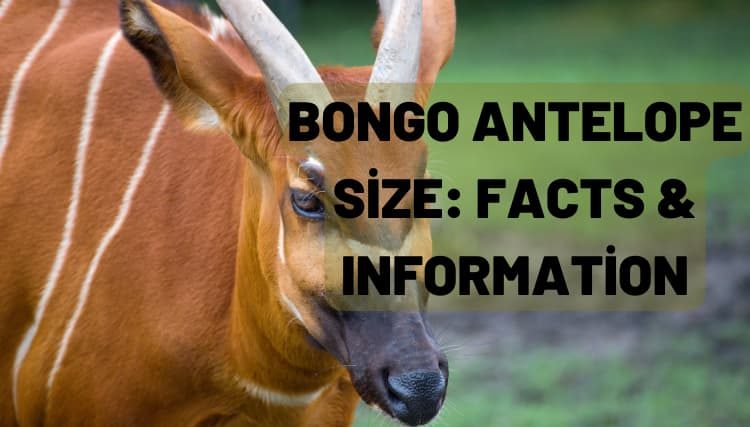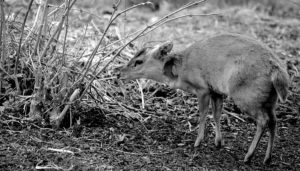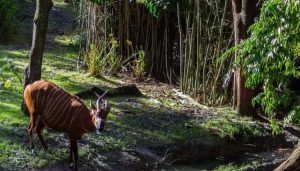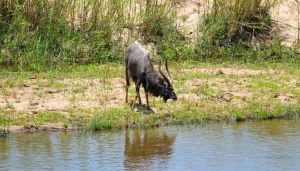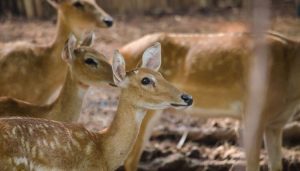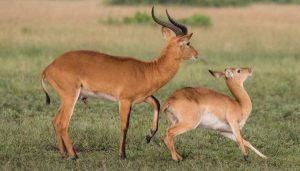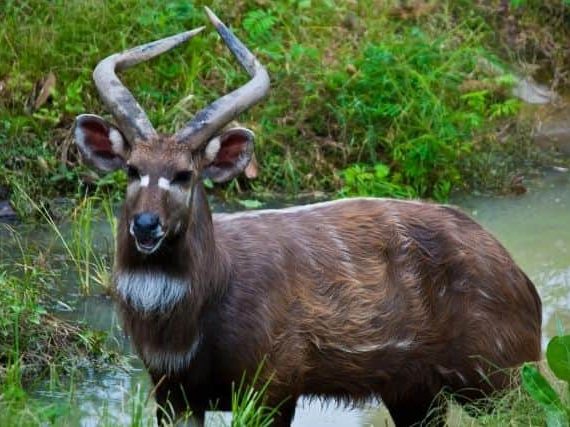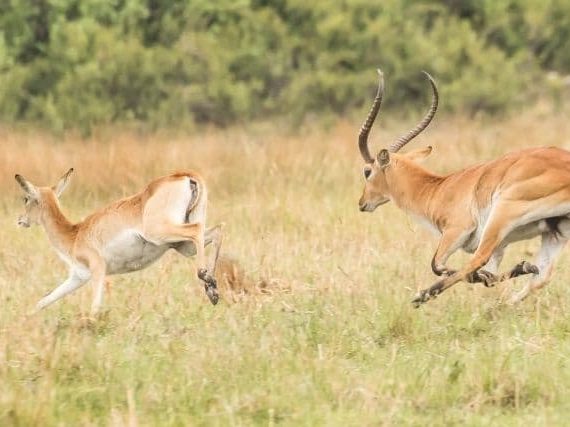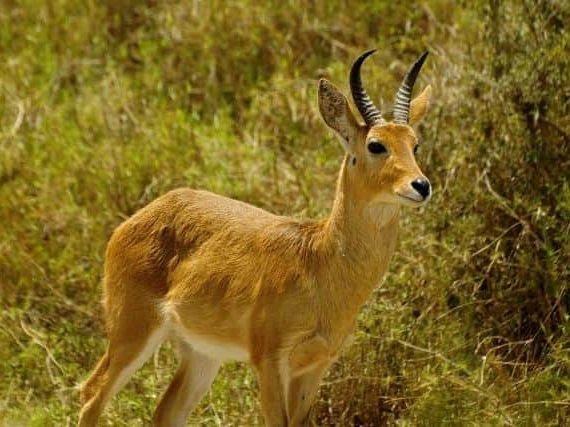Ready to learn about one of the largest forest antelopes in the world? Look no further than the bongo antelope! These majestic creatures are known for their impressive size, with males weighing up to a whopping 900 pounds and females around 500 pounds. Standing at a shoulder height of 4 to 5 feet, bongos are hard to miss in their natural habitat. And let’s not forget about those long, spiraled horns that can grow up to 40 inches in length!
But did you know that the size of bongo antelopes can vary depending on their habitat and subspecies? So if you’re curious about African bongo antelopes or want more bongo antelope facts, keep reading. We’ll even touch on topics like bongo animal size and population, as well as discuss female bongos. Get ready for an adventure into the world of these magnificent creatures!
Comparison of Bongo Antelope Size to Other Antelope Species
Bongo antelopes are the largest forest antelopes, with males weighing up to 400 kg, making them larger than most other antelope species. However, bongos are not the largest.
Largest and Smallest Antelope Species
The eland is one of the largest antelopes in the world, with males weighing up to 942 kg. Elands are savanna antelopes that inhabit grasslands and open forests across Africa. They have a distinctive dewlap (a loose fold of skin) under their necks and a light brown coat. Despite their large size, they can run at speeds of up to 40 miles per hour.
On the other hand, impalas are much smaller than bongo antelopes, with males weighing only up to 76 kg. Impalas are also savanna antelopes found in eastern and southern Africa. They have reddish-brown coats and white underbellies. Impalas are known for their impressive jumping ability; they can leap up to three meters high and over ten meters long.
IUCN Antelope Specialist Group Classification
According to the IUCN Antelope Specialist Group’s Red List of Threatened Species, bongo antelopes are classified as near threatened due to habitat loss and hunting. This means that although they are not currently endangered or critically endangered like some other antelope species such as the addax or scimitar-horned oryx, they may become so in the future if conservation efforts do not improve.
The IUCN Red List also classifies elands as least concern because they have a wide distribution range across Africa and their population numbers remain stable. In contrast, impalas are also classified as least concern due to their large population size and adaptability to various habitats.
Unique Physical Characteristics and Adaptations Related to Bongo Antelope Size

Bongo antelopes are one of the largest forest-dwelling antelopes in Africa, with distinctive reddish-brown coats and white stripes. But what sets them apart from other antelopes is their unique physical characteristics and adaptations related to their size.
Large Ears
One of the most notable features of bongo antelopes is their large ears. These ears can grow up to 14 inches long and are specially adapted to help them detect predators and communicate with other members of their species. Bongo antelopes have excellent hearing, which allows them to pick up on even the slightest sounds in their environment. They use this sense to stay alert for signs of danger, such as the approach of a predator or the warning calls of other animals.
Spiral Horns
Another distinctive feature of bongo antelopes is their spiral horns. These horns can grow up to 40 inches long, which is longer than any other African antelope. The spiral shape of the horns makes them particularly strong and durable, allowing bongos to use them for defense against predators or during conflicts with other males over mating rights. Interestingly, only male bongos have horns – females do not.
Prehensile Tongue
Bongo antelopes also have a prehensile tongue that they use to grasp and pull leaves from trees. This adaptation is crucial for their herbivorous diet, which consists mainly of leaves, fruits, and bark found in forested areas where they live. The tongue has small bumps called papillae that help it grip onto leaves while pulling them off branches.
Slender Legs
Finally, bongo antelopes have long, slender legs that enable them to navigate through dense forests quickly and escape predators easily. Their legs are also powerful enough for jumping over obstacles like fallen trees or streams. Bongos are built for agility and speed, which helps them survive in their natural habitat.
Population and Conservation Status
Bongo antelopes are a majestic species that inhabit the dense forests of central and west Africa. Unfortunately, these beautiful creatures are facing an ongoing population decline due to habitat loss, poaching, and hunting. In this section, we will discuss the current conservation status of bongo antelopes and the efforts being made to protect them.
The Species Survival Plan Participant
To protect bongo antelopes from extinction, a species survival plan participant has been established. This program aims to increase the number of bongo antelopes by promoting breeding in captivity and releasing them into the wild. It seeks to educate people about the importance of conserving these animals.
Isolated Populations
Isolated populations of bongo antelopes are particularly vulnerable to genetic diversity loss. This is because they are cut off from other populations, which limits their gene pool. As a result, special conservation efforts must be implemented for isolated populations to ensure their survival.
Near Threatened Classification
Despite these challenges, the bongo antelope is currently classified as “near threatened.” This means that while they are not yet considered endangered, their population is declining rapidly enough that they could become endangered shortly if conservation efforts do not continue.
Protection Efforts
Efforts are being made to protect bongo antelopes through various methods such as creating protected areas where hunting is prohibited and implementing anti-poaching measures. Education programs have been established to raise awareness about the importance of preserving these animals.
Habitat and Distribution
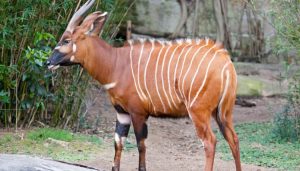
Bongo antelopes, scientifically known as Tragelaphus eurycerus, are native to the lowland forests and forest mosaics of Central and West Africa. These beautiful creatures prefer areas with dense vegetation, such as mountain forests and lowland forests with high rainfall.
Habitat Destruction
Sadly, habitat destruction due to deforestation and human activity has led to a decline in bongo antelope populations. As their natural habitats continue to be destroyed, these animals are forced to migrate elsewhere or face extinction. This is why conservation efforts are crucial in preserving the species.
Captivity for Conservation Purposes
Fortunately, bongo antelopes are also found in North America where they are kept in captivity for conservation purposes. Zoos and wildlife parks have played a significant role in breeding these animals to increase their population numbers.
Physical Characteristics
Males have distinctive white markings on their faces while females have yellow stripes on their bodies. The males’ striking white stripes help them attract mates while the females’ yellow stripes make them less visible to predators when they’re hiding among the tall grasses.
Social Behavior
Bongo antelopes live in herds of up to 20 individuals, with older males often living alone. They communicate through vocalizations such as grunts, bleats, and snorts. These sounds help them warn each other of danger or signal for mating opportunities.
Ecology and Behavior
Bongo antelopes are fascinating animals that have unique ecological and behavioral traits. These mammals belong to the genus Tragelaphus and are one of the largest forest-dwelling species in Africa. In this section, we will discuss their behavior, diet, habitat, and conservation efforts.
Social Behavior
Bongo antelopes are social animals that live in groups of up to 20 individuals. Females lead the group while males compete for dominance during mating season using their large size and impressive horns. These antelopes have a complex communication system that includes vocalizations, scent marking, and body language.
Diet and Habitat
Bongo antelopes are herbivores that feed on leaves, fruits, and other plant materials. Their brown coat helps them blend into their surroundings for survival. In the wild, bongo antelopes are found in the forests of East and West Africa where they can find enough food sources to sustain themselves.
Captive Management
Bongo antelopes are also managed in zoos around the world as part of species conservation efforts. A study on captive bongo antelopes found that they tend to be more active at night and rest during the day which is similar to their behavior in the wild. Zoos play an important role in preserving endangered species such as bongo antelopes by providing them with a safe environment where they can breed successfully.
Conservation Efforts
The western subspecies of bongo antelope (Tragelaphus eurycerus) is critically endangered due to habitat loss from deforestation, hunting for bushmeat, and disease outbreaks. Conservation organizations such as The Bongo Surveillance Project work tirelessly to protect these animals through research, monitoring populations, educating local communities about sustainable practices, and implementing anti-poaching measures.
Natural Predators of Bongo Antelopes

Bongo antelopes, also known as Tragelaphus eurycerus, are large and beautiful animals that inhabit the forests of East Africa, particularly in Kenya. Unfortunately, these majestic creatures face several threats from natural predators and human activities. In this section, we will discuss the various natural predators of bongo antelopes and their impact on the population.
Predators of Bongo Antelopes
Leopards and spotted hyenas are among the top predators of bongo antelopes. These carnivorous animals hunt bongos for food and can be found in areas where bongos live. Lions and African wild dogs are also known to prey on bongos in Kenya.
Threats from Humans
Bongo antelopes living in central Kenya, especially around Mount Kenya, face additional threats from humans who hunt them for their meat and horns. Despite conservation efforts by the Kenyan government to protect these animals, poaching still occurs. The demand for bushmeat and traditional medicine made from animal parts is a significant driver of illegal hunting activities.
Conservation Efforts
The Kenyan government has established several protected areas to help safeguard bongo antelopes and other wildlife from human activities. These include national parks like Aberdare National Park, which is home to a significant population of bongos. Conservation organizations such as the African Wildlife Foundation work with local communities to promote sustainable land use practices that benefit both people and wildlife.
Positive Economic Importance for Humans
Bongo antelopes are not only fascinating creatures but also hold great economic importance for humans. Here are some of how bongos contribute to local economies and conservation efforts:
Hunted for Meat and Hides
Bongo antelopes have been hunted for centuries by local communities in Africa for their meat and hides. The meat is a valuable source of protein, while the hides are used to make clothing, bags, and other items. Hunting bongos provides income opportunities for these communities, helping them sustain their livelihoods.
Trophy Hunting Male Bongos
Male bongos are often targeted by trophy hunters who pay large sums of money to hunt these elusive creatures. This generates revenue that can be used to fund conservation efforts aimed at protecting the species. By allowing trophy hunting of male bongos under strict regulations, countries like Cameroon have been able to successfully conserve their populations.
Valuable for Ecotourism
Bongo antelopes are highly valued by tourists who come from all over the world to see them in their natural habitat. Female bongos, in particular, are known for their elusive nature and unique appearance, making them popular among wildlife enthusiasts and photographers. Ecotourism provides an alternative source of income for local communities while also promoting conservation efforts.
Habitat Protection Benefits Other Wildlife
Conservation efforts aimed at protecting bongo antelopes have led to the preservation of their habitat as well. This benefits other wildlife species that share the same ecosystem as bongos. For example, preserving forest habitats ensures that other endangered species like gorillas and chimpanzees have a haven.
Negative Economic Importance for Humans
Gene loss in bongo antelopes can have negative economic impacts on humans. With the decline in genetic diversity, bongo antelopes become more susceptible to diseases and parasites, which can spread to livestock and crops. Farmers may experience reduced yields or even complete crop failure due to the spread of these diseases.
The loss of genetic diversity in bongo antelope populations can also negatively impact ecotourism, which is an important source of income for many communities. When there are fewer bongo antelopes to see, tourists may be less likely to visit the area, leading to a decline in tourism revenue.
In addition to the impact on farmers and ecotourism, gene loss in bongo antelopes can also affect other industries such as pharmaceuticals. Many drugs are developed using compounds found in plants and animals, including those that live in the wild. With fewer bongo antelopes available due to gene loss, researchers may have a harder time finding compounds that could lead to new drug discoveries.
It’s not just about losing a species either; it’s about losing unique genes within that species. Each animal has its own set of genes that make it different from others within its population. These unique genes could hold valuable information that we don’t yet understand or appreciate. Losing them could mean missing out on potential breakthroughs in medicine or biotechnology.
How Many Bongos Are Left in the Wild?
Bongo populations have been declining significantly in the wild due to habitat loss and hunting. There are four subspecies of bongos: mountain, eastern, western, and lowland. Each of these subspecies has a different population size, with some being more endangered than others.
The Four Subspecies of Bongos
The mountain bongo is the most endangered subspecies with only around 100 individuals left in the wild. These bongos are found only in Kenya’s Aberdare Mountains and are threatened by habitat loss due to deforestation and human encroachment. Hunting is also a significant threat to their survival since they are prized for their meat and horns.
The eastern bongo has a population of around 1,400 in central Africa. They can be found in countries like Sudan, Uganda, Tanzania, and Kenya. Although this subspecies is not as critically endangered as the mountain bongo, it still faces threats from habitat destruction and poaching.
The western bongo has a population of around 2,500 in West Africa. They can be found in countries like Cameroon, Nigeria, Ghana, Ivory Coast, Liberia, and Sierra Leone. This subspecies is also threatened by habitat loss due to deforestation for agriculture and logging activities.
The lowland bongo has the largest population of all subspecies with an estimated 28,000 individuals in the wild. They can be found across Central Africa from Cameroon to South Sudan. Although their population size may seem large compared to other subspecies of bongos, they too face threats from hunting and habitat destruction. The Decline of Bongo Populations
Bongos were once widespread throughout much of sub-Saharan Africa but have seen significant declines over recent decades due to various factors such as deforestation for agriculture or logging activities that destroy their natural habitats along with illegal hunting for bushmeat, hides, and horns.
The decline in bongo populations is a cause for concern since these animals play a vital role in their ecosystem. They are important seed dispersers, helping to maintain the balance of plant species within their habitat. They serve as prey for larger predators like lions and hyenas, which help regulate the predator-prey relationship in their ecosystem.
What Does a Bongo Eat?
Bongos are fascinating animals that belong to the antelope family. They are known for their striking appearance, with their reddish-brown coat and white stripes. But have you ever wondered what these majestic creatures eat? In this section, we’ll dive into the bongo’s diet and explore what they consume in their natural habitat.
Bongo: A Brief Overview
Before we get into the specifics of the bongo’s diet, let’s first understand what a bongo is. Bongos are large forest-dwelling antelopes that can weigh up to 900 pounds. They are found in Central and West Africa, primarily in dense forests and rainforests. These animals have long, spiraled horns that can grow up to 40 inches in length.
What Does a Bongo Eat?
Bongos are herbivores, which means they only consume plant matter. Their primary food sources include leaves, fruits, and bushes. However, what sets them apart from other herbivores is their unique digestive system. Bongos have four-chambered stomachs that allow them to extract nutrients from tough vegetation like bark and twigs. Bongoss are known to consume over 100 different plant species! Their diet varies depending on the season and availability of food in their habitat. During the dry season when food is scarce, bongos may resort to eating less palatable plants or even tree bark.
Where Do Bongos Live?
As mentioned earlier, bongos live in dense forests and rainforests of Central and West Africa. They prefer areas with thick vegetation cover as it provides them with ample hiding spots from predators like leopards and hyenas.
What Eats a Bongo?
While bongos don’t have many natural predators due to their large size and sharp horns, they do fall prey to big cats like leopards and lions. Humans are also a significant threat to bongos, as they are often hunted for their meat and hides.
Why are Bongos Endangered?
Bongo antelopes are currently listed as endangered due to various factors that threaten their survival. The primary reason for their decline is habitat loss, which has been caused by deforestation and human encroachment into their natural habitats. This has resulted in a significant reduction of suitable habitats, making it difficult for bongos to find food and mates.
In addition to habitat loss, bongos also face threats from hunting and poaching. They are often hunted for their meat, hides, and horns, which are highly valued in some cultures. As a result of these threats, the bongo population has declined significantly over the years.
Conservation efforts have been put in place to protect the remaining bongo populations. These include creating protected areas where hunting is prohibited and implementing breeding programs to increase their numbers in captivity before reintroducing them into the wild.
However, more needs to be done to ensure the survival of this unique species. We must continue to raise awareness about the threats facing bongos and take action to protect their habitats. By doing so, we can help ensure that future generations will be able to appreciate these magnificent creatures.
In conclusion, understanding why bongos are endangered is crucial if we want to save them from extinction. We must take action now before it’s too late. Let us all work together towards protecting these beautiful animals and preserving their natural habitats for generations to come.
- Lowland Bongo Antelope: The Largest Species of Antelope – Life
- Southern Reedbuck Antelope: What You Need to Know

